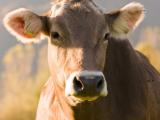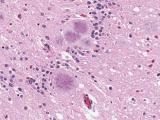Editor's note: Some material was added to this story Mar 16.
Mar 15, 2004 (CIDRAP News) Secretary of the US Department of Agriculture (USDA) Ann Veneman this afternoon announced an expanded program of surveillance for bovine spongiform encephalopathy (BSE) in the United States. Preparations for the increased testing will begin immediately and the program is expected to be fully operational by June 1. The new testing procedures will be in place for 12 to 18 months, after which an assessment will determine future plans.
"The intensive one-time surveillance effort will allow us to determine more accurately whether BSE is present in the US cattle population, and if so, estimate the level of disease. By expanding our surveillance, we will be able to provide consumers, trading partners, and industry increased assurances about the BSE status of the U.S. cattle population," states the new plan, which was published on the USDA Web site today.
The new plan incorporates last month's recommendations from the international scientific review panel and it is supported by the Harvard Center for Risk Analysis, Veneman said at a press briefing. It calls for testing a much larger number of specimens from the high-risk BSE cattle population than the current 40,000 per year as well as about 20,000 random samples from normal-appearing adult cows.
Cattle at high risk for BSE are estimated to number approximately 446,000 currently in the United States. The definition of high risk, based on experience in the United Kingdom and Europe, includes adult cattle that are nonambulatory ("downers"), dead on the farm, or showing clinical signs consistent with BSE.
Ron DeHaven, the USDA's chief veterinary officer, said at the briefing that the expanded program would mean testing "as many as we possibly can" of the target population of cattle. He explained that the new testing would allow for identification of BSE at a rate of 1 in 10 million cattle with a confidence level of 95% if 201,000 samples were tested and a confidence level of 99% if 268,000 samples were tested.
Testing will be done at 17 state and university laboratories, with confirmation of any positive results at the National Veterinary Services Laboratory in Ames, Iowa. Funding for the new program totals $70 million.
When questioned about proposals to test 100% of cattle, DeHaven said that science does not justify this level of testing and that, while the USDA is still evaluating the proposals, testing at this level would be solely for marketability and export purposes. The USDA's newly enhanced program, he said, is strictly for surveillance purposes and will determine whether and at what level BSE exists in the target cattle population.
DeHaven said the expanded testing program will rely on rapid screening tests, several of which the USDA is currently evaluating. "We would anticipate in two or three months' time being able to license perhaps a couple or more of those tests," he said.
Because the screening tests are designed to be very sensitive, some false-positive results are expected, DeHaven said, adding, "That's just the nature of the beast." The national laboratory in Ames will use immunohistochemical staining, considered the "gold standard" in BSE testing, to confirm any positives.
DeHaven said the USDA has made no decision yet on the proposal by Creekstone Farms of Arkansas City, Kan., to test all its cattle so the beef can be exported to Japan and other Asian markets.
The USDA will collect samples from high-risk cattle at a variety of places, including federally inspected slaughter plants, farms, rendering plants, veterinary diagnostic laboratories, pet food plants, and livestock sale barns, DeHaven said.
To test a random sample of healthy older cattle, the USDA will focus its main efforts on 40 slaughter plants in 17 states, according to DeHaven. Those plants slaughter more than 86% of all cattle in the nation, he said.
Under questioning, DeHaven refused to give a specific target for the number of high-risk cattle to be tested. "To estimate how many we will be able to collect is simply premature," he said. "It's possible that we would collect somewhere less than 200,000 and still have a very statistically valid sampling."
DeHaven said USDA veterinarians will work with state veterinarians and other state officials to develop plans for collecting cattle samples for testing in each state.
See also:
Transcript of USDA's Mar 15 news briefing
http://www.usda.gov/Newsroom/0106.04.html
Robert Roos, CIDRAP News Editor, contributed to this story.


















